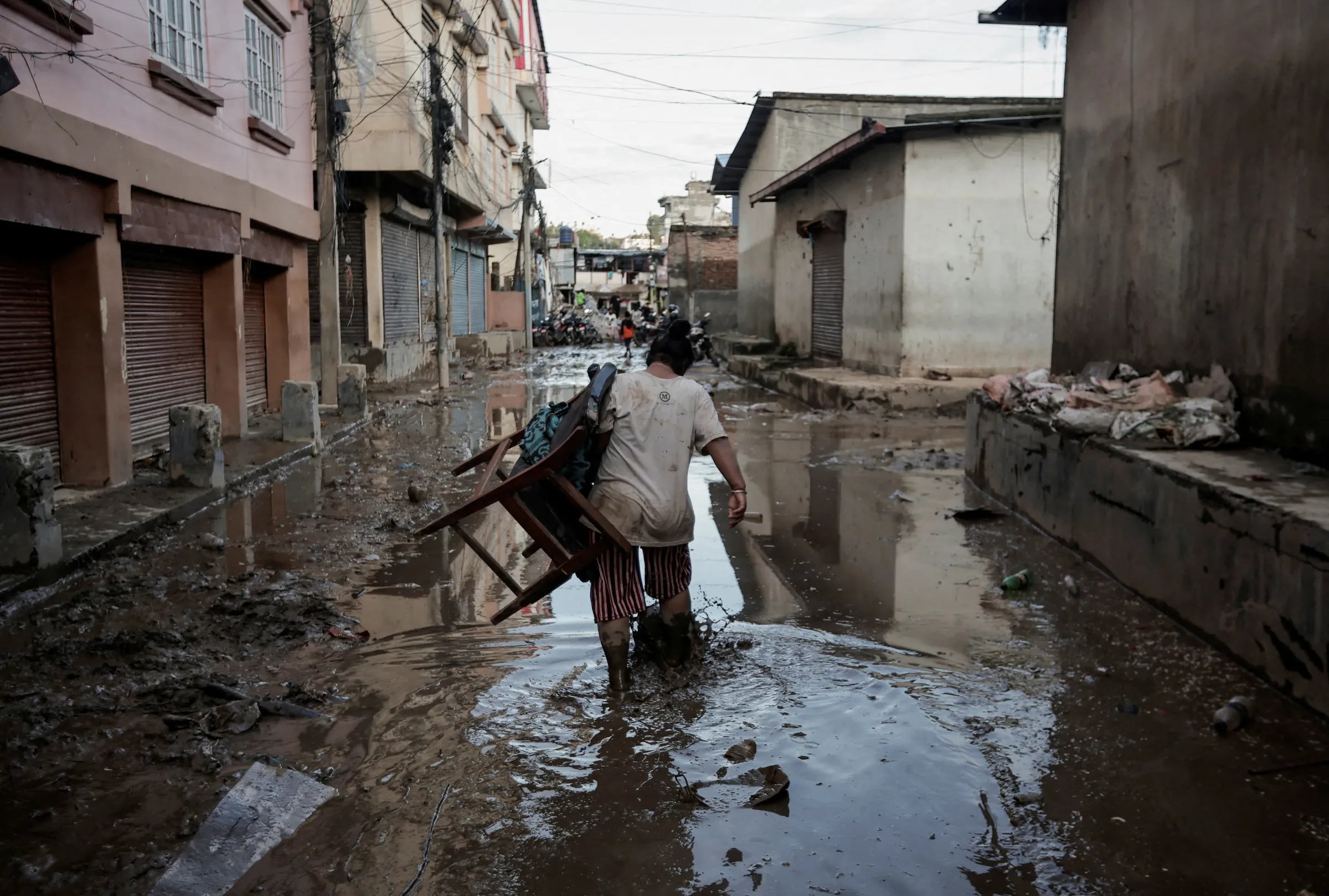Cheikh Diong: Loss and damage fund must be robust, deliver relief

A woman carrying a chair walks along a muddy street as the floodwater recedes from a residential area that was flooded by the overflowing Bagmati River following heavy rains in Kathmandu, Nepal September 29, 2024. REUTERS/Navesh Chitrakar
The loss and damage fund is more than a financial tool; it is a testament to our shared humanity and more resources are essential
Ibrahima Cheikh Diong is executive director of the Fund for responding to Loss and Damage (FRLD).
This week’s COP29 climate talks in Baku will focus on the need for much bigger investments to help vulnerable developing countries cope with the costs of climate change, including paying for the loss and damage caused by extreme climate events.
Through my previous work at the African Risk Capacity (ARC) group addressing climate risks, I have experienced firsthand how climate change can hurt vulnerable communities. The southern African region, for example, is experiencing one of its worst droughts in decades, and I’ve seen how emergency cash transfers can dramatically improve food security.
Quickly addressing the loss and damage caused by climate change can stop it from threatening the very fabric of life for the most vulnerable in developing countries. Many nations could plunge into extreme poverty if we do not address this. Projections suggest that by mid-century, global loss and damage could surpass $1 trillion a year. Developing nations alone could experience loss and damage ranging from $290 – 580 billion by 2030.
The historic decision to establish the Fund for Responding to Loss and Damage in 2022, following years of negotiations, will address these challenges. The Fund will seek to fill a critical gap in climate finance for developing nations, with the aim of providing swift financial support to vulnerable countries when they are hit by extreme climate events.
Strengthen resilience, promote recovery
As the Fund’s first executive director reporting to an experienced, inclusive and diverse board, I am fully committed to ensuring that the Fund becomes an essential component of the global climate response. It must do this by supporting country-led approaches that strengthen resilience and promote recovery from the effects of climate change.
Our board is fully committed to engaging with the fund’s key participants and listening to their concerns.
The financial sustainability of the Fund is crucial for its long-term success. COP28 yielded significant financial commitments of close to $700 million to address loss and damage. These pledges are commendable and instill confidence in the Fund's mission. But more resources are essential.
COP29 is focusing heavily on finance. Our priority will be to convert the pledges from COP28 into tangible resources to support the Fund's critical work. Raising more money will also be a top priority. We aim to build on the important discussions at COP28, engaging with donor partners to secure more funding and meet the substantial demand for financial support from developing countries.
Tangible relief and support
As we refine how the Fund will operate, much more work lies ahead. Our priority is to establish a financial instrument that is not only credible but also meets the expectations of our diverse stakeholders. We aim to continuously engage stakeholders to understand and reconcile their needs and expectations. These insights will be instrumental in shaping the Fund’s operational strategies, including how its resources are accessed.
The needs and voices of the people we serve, particularly those on the frontlines of climate change, must remain at the forefront. Once operational, we want the Fund to distribute funding effectively and fairly for immediate and short-term recovery needs. We will work to develop simplified processes and eliminate any bureaucratic hurdles. The Fund will also draw from lessons learned in the climate finance space to build an institution that is responsive and adaptable to an evolving landscape.
Finally, we are committed to ensuring that the Fund is not just a symbol of our intentions but a robust mechanism that will deliver tangible relief and support to developing nations. We must continue to nurture and amplify the collaborative spirit that has brought us this far. Our collective action will determine the resilience of communities facing existential threats from climate change.
We must move forward with a sense of urgency, knowing that every delay risks more lives and livelihoods, particularly in the most vulnerable communities. The Fund for responding to Loss and Damage is more than a financial instrument; it is a testament to our shared humanity and our resolve to protect those who are most at risk.
Together, we can make a difference, and the time for action is now.
Any views expressed in this opinion piece are those of the author and not of Context or the Thomson Reuters Foundation.
Tags
- Climate and health
- Loss and damage
Go Deeper
Related
Latest on Context
- 1
- 2
- 3
- 4
- 5
- 6
Most Read
- 1
- 2
- 3
- 4
- 5

















